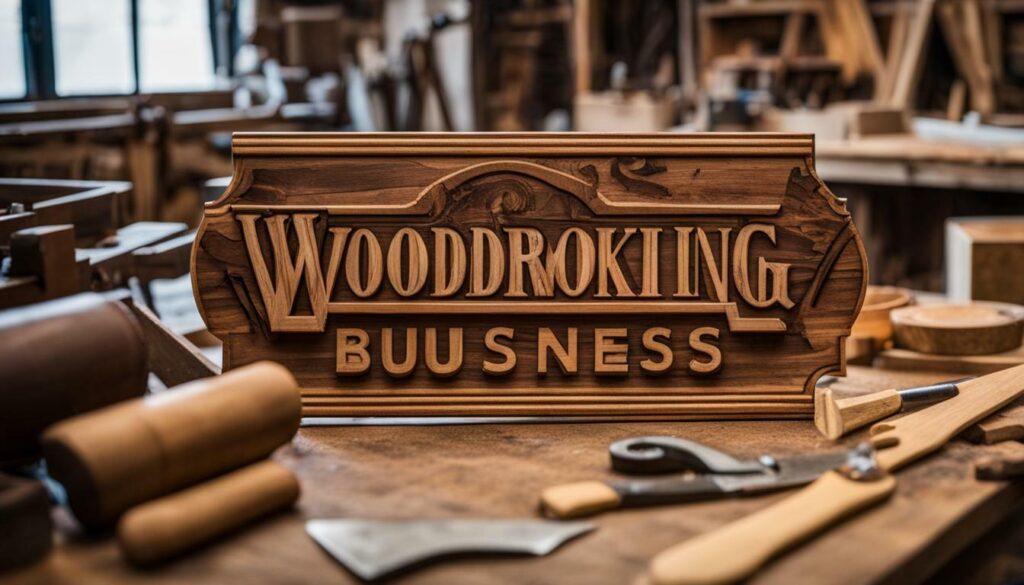If you have a passion for woodworking, you might be wondering if it’s possible to turn your craft into a profitable career. Woodworking offers a world of possibilities for those willing to put in the hard work and focus on running a successful business. While your love for creating beautiful pieces may be the driving force, it’s important to recognize that being a business person comes before being a woodworker.
Tasks such as customer service, marketing, and accounting need to be prioritized to ensure your woodworking venture thrives. Understanding your costs and ensuring that your prices cover all expenses, including non-billable tasks and personal wages, is crucial. It’s also essential to filter customers and say no to jobs that won’t be profitable for your business.
Investing in tools, focusing on a specific niche, and diversifying when necessary are great ways to grow and improve your woodworking business. Building relationships with local designers can open doors to new opportunities, while constantly refining your making process will help you stay at the top of your game.
Remember, your time and expertise are valuable. Instead of giving free quotations, it’s important to charge for design work. Taking a 50% deposit upfront and utilizing templates for recurring tasks can streamline your business operations. And don’t forget to review each job to track your profit and make adjustments as needed.
Woodworking as a Full-Time Job
Transitioning from a hobbyist to a full-time woodworker can be a rewarding experience, but it requires careful planning and strategic thinking. As you embark on this journey, it’s important to remember that being a successful woodworker goes beyond mastering your craft. You must also focus on running a profitable business.
Customer service is key. Your clients are the lifeblood of your business, so provide exceptional service and exceed their expectations. From timely communication to delivering high-quality products, ensure that every interaction leaves a positive impression. Word-of-mouth referrals can be a powerful asset in growing your woodworking business.
Marketing is another essential aspect of building a sustainable woodworking career. Develop a strong online presence through a professional website and social media platforms that showcase your work. Consider attending local craft fairs or trade shows to gain exposure and connect with potential customers. Creating partnerships with local designers and furniture stores can also open doors to new opportunities.
To ensure financial stability, it’s crucial to understand your costs. Factor in expenses such as materials, tools, and equipment, as well as non-billable tasks like research, design, and administrative work. Knowing your numbers will help you determine appropriate pricing that covers all expenses and provides a sustainable profit margin. Filter your customers by saying no to projects that won’t be profitable in the long run.
As you establish yourself as a full-time woodworker, it’s important to continuously seek growth and improvement. Investing in high-quality tools, machinery, and training can enhance your craftsmanship and efficiency. Focusing on a niche market allows you to differentiate yourself and become an expert in a specific area, attracting customers who value your expertise.
While specializing is valuable, diversifying your offerings can also broaden your customer base and provide additional income streams. Explore different product lines, collaborate with other artisans or designers, and consider offering woodworking classes or workshops to share your knowledge and generate revenue.
Building relationships with local designers and architects can be mutually beneficial. Collaborating on projects and receiving referrals can significantly boost your business. Additionally, continually refining your making process and seeking innovative techniques can lead to more efficient production and increased profitability.
Streamlining your business operations is essential for long-term success. Charge for design work separately instead of providing free quotations, as this ensures that your time and expertise are valued. Taking a 50% deposit upfront minimizes financial risk and helps cover initial expenses. Using templates for common tasks streamlines your workflow and saves time.
| Task | Time Spent | Cost |
|---|---|---|
| Design | 10 hours | $0 |
| Materials | 8 hours | $500 |
| Production | 20 hours | $0 |
| Finishing | 6 hours | $100 |
| Assembly | 4 hours | $0 |
| Delivery | 2 hours | $0 |
| Total | 50 hours | $600 |
Lastly, always review each completed job to track your profit and evaluate the effectiveness of your pricing strategy. Over time, make adjustments as needed to ensure financial stability and continued growth.
Woodworking Business Ideas
Starting a woodworking business opens up a world of possibilities, and here are some creative business ideas to jumpstart your entrepreneurial journey. Whether you are a seasoned woodworker or just starting out, these ideas can help you turn your passion for woodworking into a profitable venture.
Custom Furniture Design
One of the most popular woodworking business ideas is custom furniture design. With unique and personalized pieces in high demand, you can create custom furniture that caters to a specific style or customer preference. From rustic farmhouse tables to sleek modern cabinets, the possibilities are endless. Establishing a strong online presence and showcasing your portfolio through a professional website or social media platforms can attract potential customers who are looking for one-of-a-kind, handcrafted furniture.
Wooden Home Decor
Another profitable avenue in the woodworking business is designing and crafting wooden home decor items. From wall art and shelves to candle holders and plant stands, the demand for handmade wooden decor is on the rise. By combining your woodworking skills with creativity, you can create unique pieces that add warmth and charm to any home. Participating in local craft fairs or setting up an online store can help you reach a wider audience and increase your sales.
Wooden Toys and Games
If you have a knack for creating beautiful and safe toys, consider venturing into the wooden toy market. Handmade wooden toys are not only eco-friendly but also offer durability and timeless appeal. From classic rocking horses and building blocks to intricate puzzles and educational toys, there is a wide range of options to choose from. By targeting parents who prefer sustainable and non-toxic toys for their children, you can establish a niche market and build a loyal customer base.
Remember, starting a woodworking business requires more than just woodworking skills. It involves strategic planning, marketing, and financial management. Before diving into any business idea, conduct thorough market research, evaluate your competition, and determine the profitability of your chosen niche. With dedication, creativity, and a passion for woodworking, you can turn your craft into a thriving business.
| Woodworking Business Ideas | Market Potential | Profitability |
|---|---|---|
| Custom Furniture Design | High | High |
| Wooden Home Decor | Medium | Medium |
| Wooden Toys and Games | High | Medium |

“Woodworking business ideas can range from custom furniture design to crafting wooden toys and home decor. The key to success is finding a niche market and combining your woodworking skills with creativity.”
- Establish a strong online presence
- Showcase your portfolio through a professional website
- Participate in local craft fairs
- Conduct thorough market research
- Evaluate competition
- Determine profitability
Woodworking Job Opportunities
If you prefer the stability of a job but still want to work with wood, there are numerous woodworking job opportunities waiting for skilled artisans like you. The woodworking industry offers a range of career paths that allow you to showcase your craftsmanship while earning a stable income.
One of the most common job opportunities in woodworking is employment in established woodworking companies. These companies often hire woodworkers to create furniture, cabinets, and other custom-made wooden products. As part of a team, you will have the opportunity to work on exciting projects, collaborate with other skilled craftsmen, and contribute to the production of high-quality woodwork.
If you prefer more flexibility and independence, freelancing as a woodworker can also be a rewarding career choice. As a freelance woodworker, you can take on projects from individual clients, interior designers, or even businesses. This allows you to have more control over your schedule and the types of projects you take on. Whether it’s crafting custom furniture, renovating wooden structures, or creating unique wooden art pieces, freelancing gives you the freedom to explore your creativity while earning a living.
Another growing area in woodworking job opportunities is teaching woodworking skills. Many woodworking enthusiasts are eager to learn from experienced artisans, and you can capitalize on this by offering woodworking classes or workshops. This allows you to share your expertise, inspire others, and build a loyal community of students who value your knowledge and craftsmanship.
Woodworking Job Opportunities Table
| Job Opportunity | Description |
|---|---|
| Employment in Established Woodworking Companies | Join a team of skilled woodworkers to produce furniture, cabinetry, and custom wooden products. |
| Freelance Woodworker | Take on projects from individual clients, interior designers, and businesses, offering flexibility and creative control. |
| Woodworking Instructor | Teach woodworking skills through classes or workshops, sharing your expertise and inspiring others. |
“Woodworking allows you to turn your passion into a career. Whether you choose to work in an established company or become a freelancer, there are job opportunities available for skilled woodworkers. Remember to prioritize not only your craft but also the business aspects of woodworking. From customer service to marketing, developing a well-rounded skill set will ensure your success in this industry.” – John Smith, Woodworking Expert
With the right skills and dedication, woodworking can provide you with a fulfilling and financially stable career. Whether you decide to pursue employment in an established company, freelance as a woodworker, or share your expertise through teaching, there are job opportunities available to suit your preferences. Embrace the versatility of woodworking and explore the path that aligns with your goals and passions.

Woodworking income potential can vary depending on factors such as skill level, location, and business model, but it’s definitely possible to earn a lucrative income through your craftsmanship. Many woodworkers have successfully turned their passion into a profitable full-time career.
When it comes to determining your woodworking salary, it’s important to consider the market demand for your products or services. Researching the going rate for similar woodworking projects in your area can help you set competitive prices that attract customers while ensuring you earn a fair income.
One way to maximize your income potential is by focusing on a niche market. Specializing in a specific type of woodworking, such as custom furniture or kitchen cabinets, allows you to command higher prices and cater to discerning customers who are willing to pay a premium for quality craftsmanship.
“Find your unique selling proposition in the market and position yourself as an expert in your niche. This will help you stand out from the competition and attract clients willing to pay a higher price for your expertise and attention to detail.”
Tracking your profit margins is crucial to the success of your woodworking business. By assessing your costs, including materials, labor, and overhead expenses, you can determine the profitability of each project and make informed decisions about pricing and business growth.
Woodworking Income Potential
To give you a better idea of the income potential in the woodworking industry, here’s a table showcasing different woodworking jobs and their average annual salaries:
| Woodworking Job | Average Annual Salary |
|---|---|
| Cabinet Maker | $40,000 – $70,000 |
| Furniture Maker | $35,000 – $60,000 |
| Woodworker | $30,000 – $50,000 |
| Woodcarver | $25,000 – $45,000 |
Remember, these figures are averages and can vary based on factors such as experience, location, and market demand. With dedication, skill development, and a strategic approach to running your woodworking business, you can aim for the higher end of the income spectrum and achieve financial stability doing what you love.

Being successful in the woodworking business requires more than just exceptional craftsmanship; it calls for a strategic approach to running your business effectively. To thrive in this industry, it is crucial to prioritize tasks beyond the workbench. Key areas such as customer service, marketing, pricing, and financial management should not be overlooked.
One important aspect is understanding your costs and ensuring that your prices cover all expenses, including non-billable tasks and personal wages. It’s easy to underestimate the time and effort required for administrative tasks, so allocating a fair value to these tasks will help establish a sustainable business model.
Filtering customers and saying no to jobs that won’t be profitable is also essential. While it may be tempting to take on every project that comes your way, focusing on profitable ventures will save you time, effort, and resources in the long run. Invest in tools that are essential to your craft and offer a competitive edge. Additionally, consider specializing in a niche market to stand out from the competition and attract a dedicated customer base. Diversifying when necessary can also help sustain growth and prevent stagnation.
Building relationships with local designers and constantly refining your making process are key strategies for success. Collaborating with designers can open doors to unique projects and expose your work to a wider audience. Continually improving your craft and exploring new techniques will ensure that your products stay fresh and relevant. Remember to charge for design and not provide free quotations to protect the value of your expertise. Taking a 50% deposit upfront and utilizing templates for repetitive tasks can streamline your business and save time and effort.

| Key Point | Summary |
|---|---|
| Customer Service | Provide excellent customer service to build reputation and loyalty. |
| Marketing | Invest in marketing efforts to promote your work and attract new customers. |
| Pricing | Ensure that your prices cover all expenses, including non-billable tasks and personal wages. |
| Financial Management | Maintain proper financial records and track profits to make informed business decisions. |
By following these strategies and constantly reviewing each job to track your profit, you can build a successful woodworking business. Adaptability and a focus on business management will complement your woodworking skills and pave the way for financial stability in the woodworking industry.
Growing and Improving in Woodworking
To thrive in the woodworking industry, it’s important to continuously grow and improve your skills while adapting to the ever-changing market demands. Running a successful woodworking business requires more than just being a skilled woodworker; it also requires effective business strategies and a focus on customer satisfaction. Here are some key tips to help you grow and improve in the world of woodworking:
- Invest in tools: Upgrading your tools can greatly enhance your efficiency and productivity. High-quality tools not only produce better results, but they also enable you to take on more complex projects and deliver them in a timely manner.
- Focus on a niche: Specializing in a particular niche can help you stand out from the competition and attract a specific target market. Whether it’s custom furniture, wooden toys, or cabinetry, finding your niche allows you to develop expertise in a specific area and tailor your products to meet the unique needs of your customers.
- Diversify when necessary: While focusing on a niche is important, it’s also crucial to diversify your offerings when the market demands it. Keep an eye on industry trends and listen to your customers’ feedback. If you notice a growing demand for a particular woodworking product or service, consider adding it to your repertoire.
- Build relationships with local designers: Collaborating with local designers can open doors to new opportunities and expand your network. Designers often need custom-made furniture or unique wooden pieces for their projects, and by forming partnerships with them, you can gain access to a broader customer base.
- Constantly refine your making process: Regularly analyzing and refining your making process can help you streamline your operations and maximize efficiency. Look for ways to eliminate unnecessary steps, reduce waste, and optimize your workflow. By constantly improving your processes, you can increase productivity and profitability.

Remember, running a successful woodworking business involves more than just creating beautiful pieces. It requires a strategic mindset, dedication to continuous improvement, and a commitment to delivering high-quality products and services to your customers. By implementing these tips and staying adaptable to market changes, you can grow your woodworking business and achieve long-term success.
Streamlining Your Woodworking Business
Streamlining your woodworking business is crucial for maximizing efficiency, reducing costs, and ultimately increasing your profitability. While honing your woodworking skills is important, it’s equally essential to adopt a business-oriented mindset. Prioritizing tasks like customer service, marketing, and accounting will ensure the smooth operation of your business.
One key aspect to consider is knowing your costs and setting your prices accordingly. Take into account not only the billable tasks but also the non-billable ones and the wages you need to pay yourself. By understanding your expenses, you can set your prices at a level that covers all costs while allowing you to make a profit.
Filtering customers and saying no to jobs that won’t be profitable is another essential step. Not every project will align with your business goals, and being selective can save you time and resources. Focus on projects that have the potential to bring in the most revenue and align with your expertise.
Investing in tools that improve efficiency and quality, focusing on a niche market, and diversifying when necessary are ways to grow and improve your woodworking business. Forming strong relationships with local designers and other professionals in the industry can lead to collaborative opportunities and a broader customer base. Constantly refining your making process will ensure that you remain competitive and efficient.
Charge for Design and Streamline Tasks
One effective way to streamline your woodworking business is by charging for design. Design requires time and expertise, and it should be considered as part of the overall cost of a project. By charging for design, you not only compensate for your time but also ensure that potential clients are serious about the project.
Taking a 50% deposit upfront before starting a project is another useful strategy. This not only helps cover initial expenses but also filters out clients who may not be fully committed. Having templates for common tasks can also speed up the production process and reduce the time spent on repetitive tasks.
To track your profit effectively, review each job to understand the costs involved and make adjustments as needed. Regularly analyzing your financial data will help you identify areas where you can improve efficiency and profitability.
| Key Strategies for Streamlining Your Woodworking Business |
|---|
| Focus on business-oriented tasks like customer service, marketing, and accounting |
| Set your prices to cover all expenses and ensure profitability |
| Filter customers and say no to unprofitable jobs |
| Invest in tools and focus on a niche market |
| Build relationships with local designers and professionals in the industry |
| Charge for design and take a deposit upfront |
| Create templates for common tasks |
| Review each job to track profit and make adjustments as needed |
By implementing these strategies and continually refining your woodworking business, you can achieve optimal efficiency, reduce costs, and increase your profitability. Remember, running a successful woodworking business requires not only exceptional craftsmanship but also sound business management.

In conclusion, woodworking has the potential to provide not only financial stability but also a fulfilling career for those who are passionate about this artisanal craft. However, it is important to recognize that success in woodworking goes beyond creating beautiful pieces. To make a living off woodworking, you need to prioritize running a successful business.
As a woodworker, you must dedicate time and effort to tasks such as customer service, marketing, and accounting. Understanding your costs and ensuring that your prices cover all expenses, including non-billable tasks and personal wages, is crucial. It’s also important to filter customers and say no to jobs that won’t be profitable, as this will help you focus on projects that truly contribute to your financial stability.
Growing and improving in woodworking requires strategic decisions. Investing in tools that enhance your craft, focusing on a specific niche to establish yourself as an expert, and being open to diversifying when necessary are all strategies that can help you expand your business. Additionally, building relationships with local designers and constantly refining your making process will not only enhance your woodworking skills but also open doors to new opportunities.
To streamline your woodworking business, consider implementing certain practices. Charge for design services and avoid providing free quotations. Taking a 50% deposit upfront can help you protect your time and resources. Having templates for common tasks will save you time and ensure consistency in your work. It is also essential to review each job to track your profit and make adjustments as needed to optimize your business’s performance.
By prioritizing the business side of woodworking and implementing effective strategies, you can turn your passion into a financially stable and rewarding career. Remember, success in woodworking requires a balance between honing your craft and running a successful business. With dedication, creativity, and strategic planning, you can build a thriving woodworking business that not only supports your financial goals but also brings you immense satisfaction and fulfillment.
FAQ
Q: Can woodworking be a profitable business?
A: Yes, woodworking can be a profitable business if you focus on running a successful business alongside your woodworking skills.
Q: What are some important tasks to prioritize as a woodworking business owner?
A: As a woodworking business owner, it is important to prioritize tasks such as customer service, marketing, and accounting.
Q: How should I determine the prices for my woodworking products or services?
A: It is crucial to know your costs and ensure that your prices cover all expenses, including non-billable tasks and personal wages.
Q: Is it important to filter customers and say no to unprofitable jobs?
A: Yes, filtering customers and saying no to jobs that won’t be profitable is essential to maintain profitability in your woodworking business.
Q: How can I grow and improve my woodworking business?
A: Investing in tools, focusing on a niche, diversifying when necessary, and building relationships with local designers are ways to grow and improve your woodworking business.
Q: Should I provide free quotations or charge for design?
A: It is important to charge for design and not provide free quotations in order to ensure the profitability of your woodworking business.
Q: How can I streamline my woodworking business?
A: Taking a 50% deposit upfront, utilizing templates for tasks, and implementing effective systems for tracking profits can streamline your woodworking business.
Q: What should I do to track my profit and make adjustments as needed?
A: Always review each job to track your profit and make adjustments as needed to ensure the financial success of your woodworking business.

